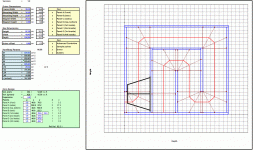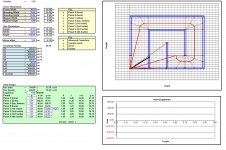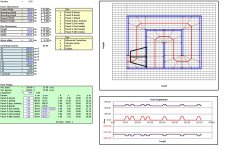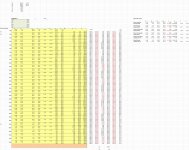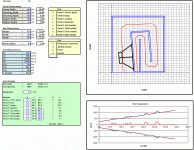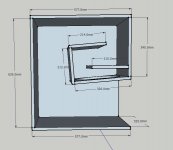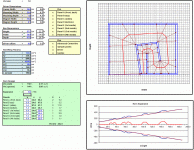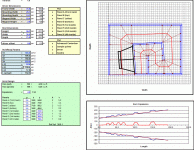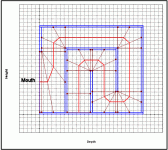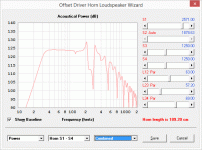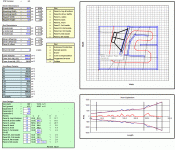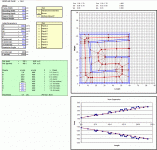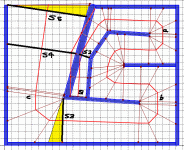On 1.1 Path tab, the formula in cell O105 needs corrected so cell D4 will read 929.03.
I don't think the formula is incorrect. It's a pretty straightforward one that's repeated for the other path sections.
Have a look at this - I think it's about as close as you're going to get for this design.
On looking for the gap between the driver and the front panel, bear in mind that you're looking for about 0.8 cm in an image that's supposed to a box that's just over 100cm wide. That may not be visible until you enlarge the graph like I did.
Attachments
I don't think the formula is incorrect. It's a pretty straightforward one that's repeated for the other path sections.
Have a look at this - I think it's about as close as you're going to get for this design.
On looking for the gap between the driver and the front panel, bear in mind that you're looking for about 0.8 cm in an image that's supposed to a box that's just over 100cm wide. That may not be visible until you enlarge the graph like I did.
Ok, what did you do to get S3 to read 929.03? I changed Expansion from 0.01 to 0.00 and got this...
Attachments
Ok, what did you do to get S3 to read 929.03? I changed Expansion from 0.01 to 0.00 and got this...
I just used Excel's "Goal Seek" feature to adjust the length of one of the panels to achieve a target of 929.03 for S3.
I've attached an updated spreadsheet for the SS15-type fold. This one includes a few new features like the option of using one of the internal panels for cone compensation, which in turn allows you to increase the path length. Also included are updated layout guides, suggested locations and cutouts for bracing, a larger version of the graph, and an instruction page for the build.
...and of course I discovered a few minor bugs afterwards. The latest version is attached.
Attachments
You mentioned a few days ago that you were thinking about a version that has the opening in the bottom panel, instead of the side panel.
Is that in progress?
Do you have a release date?
Here ya go. I much prefer this mouth arrangement.
Attachments
Nice, have been pondering the MTH30 so this will help verify its worthiness!
It works out quite well, if you use the dimensions from this site (and 14mm ply):
MTH-30
Two of the internal panels seem a little short, but that's likely because of what assumptions were made about the expansion around those sections.
Attachments
It works out quite well, if you use the dimensions from this site (and 14mm ply):
MTH-30
Two of the internal panels seem a little short, but that's likely because of what assumptions were made about the expansion around those sections.
Here's a version of the MTH-30 that should work quite well with the PA-310 12" driver from Parts Express. A ~2.5 mH inductor can be added to smooth the passband response, which extends down to just below 50 Hz. Not too bad at all. I might've tried building this if I didn't already have my POC#3.
Attachments
I'll check out the Goal Seek the next time I'm on a pc/laptop. Has anyone ever performed a test between side firing mouth vs downfiring mouth vs SS fold vs THAM fold with the exact same speaker?
Here's the "issue" I see with the "side-firing mouth". See the path predicted by the "advanced centerline" method? I suspect that the path length prediction is somewhat optimistic, as well as the effective mouth size. Of course, this might be a good thing if you're looking for a way to easily shift Fb upwards for a TH without having to rebuild the entire thing, but it also means that it's not easy to sim the results of such a build - unless we come up with a better method of predicting path length and the position of the "mouth tap" (i.e. the location of S4) and the effective mouth size.
Of course, if someone can actually build one of these things and perform some impedance measurements with different mouth sizes, we can probably do some "reverse engineering" in HornResp to see what adjustments have to be made to the sim to achieve similar impedance plots.
Attachments
I'll check out the Goal Seek the next time I'm on a pc/laptop. Has anyone ever performed a test between side firing mouth vs downfiring mouth vs SS fold vs THAM fold with the exact same speaker?
BTW, I've done both an SS fold TH and a THAM fold TH with the same driver (a Parts Express PA310) and I preferred the results I got with the SS fold. Among other things, the SS fold is a dual-expansion one that allows for a bit more flexibility wrt the physical layout in the box, and it's possible to significantly reduce the dip in the response at the upper end of the passband by choosing the correct combination of path length and expansions along the horn. Folds that only allow for one expansion like the THAM fold don't provide this flexibility.
If I was going to use a fold that only allowed for one expansion, I'd probably opt for the fold used for the MTH-30, as this type of fold allows for the use of leaving one panel removable near the mouth to gain access to the drive, if this is required.
MLTL spreadsheet
Here's a spreadsheet to assist with an MLTL design. The layout is based on the constant-taper TL spreadsheet I provided earlier. The MLTL approach appears to have some advantages over the basic constant taper approach, in that the position of S2 can be fine-tuned (by varying other parameters in the alignment). This makes it easier to commit the design to an actual build.
Here's a spreadsheet to assist with an MLTL design. The layout is based on the constant-taper TL spreadsheet I provided earlier. The MLTL approach appears to have some advantages over the basic constant taper approach, in that the position of S2 can be fine-tuned (by varying other parameters in the alignment). This makes it easier to commit the design to an actual build.
Attachments
...and of course I discovered a few minor bugs afterwards. The latest version is attached.
I've updated the spreadsheet to more correctly address "cone compensation". Basically you enter the calculated value (use HornResp's "cone volume" feature to determine this), then enter how much compensation for this you want to include in your design.
This is basically an enhanced version of the spreadsheet I used to design and build POC4, details of which can be seen here - The Subwoofer DIY Page v1.1 - Projects : "Proof of Concept #4"
Attachments
Hi Brian,... ... ...Folds that only allow for one expansion like the THAM fold don't provide this flexibility... ... ...
There are more roads to Rome than on one spreadsheet... : -)
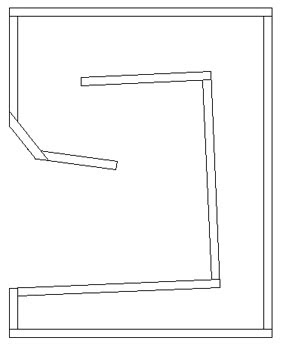
(just one of many)
Cheers,
Djim
Hi Brian,
There are more roads to Rome than on one spreadsheet... : -)

(just one of many)
Cheers,
Djim
Hmm, I think you're right. Looks like all that needs to be done is to be a bit more flexible with the position of Panel I in my spreadsheet. I'll have another look at my THAM folding spreadsheet this weekend to see what the results look like.
Attachments
I've updated the spreadsheet to more correctly address "cone compensation". Basically you enter the calculated value (use HornResp's "cone volume" feature to determine this), then enter how much compensation for this you want to include in your design.
Aargh - bug found in calculation of L45. Fixed in this version.
Attachments
Refining the "advanced centerline" model
I'm trying to refine the "advanced centerline model" (ACM) that I'm using to determine the path length and cross-sectional area through the horn layout in my excel spreadsheet, and I'm running into some challenges (see attached diagram).
One challenge I'm facing is accounting for the "discontinuities" in the horn, i.e. the sections highlighted in yellow in the image. These are sections where there are changes in the expansion that are not accounted for in the corresponding HornResp model. I'm tempted to just average out the change in CSA and use half the calculated path length in that section, but I'm open to other ideas on how to address it.
I'm trying to refine the "advanced centerline model" (ACM) that I'm using to determine the path length and cross-sectional area through the horn layout in my excel spreadsheet, and I'm running into some challenges (see attached diagram).
One challenge I'm facing is accounting for the "discontinuities" in the horn, i.e. the sections highlighted in yellow in the image. These are sections where there are changes in the expansion that are not accounted for in the corresponding HornResp model. I'm tempted to just average out the change in CSA and use half the calculated path length in that section, but I'm open to other ideas on how to address it.
Attachments
- Home
- Loudspeakers
- Subwoofers
- Spreadsheet for Folded Horn Layouts...
